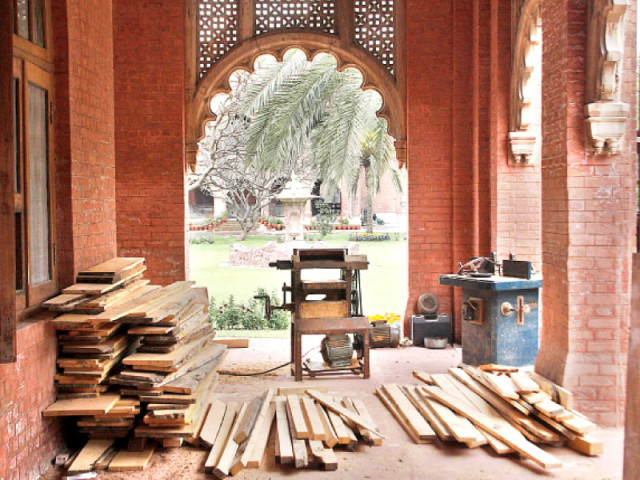New is old: Historic LHC building being restored
The restoration team has closely studied the original plans, says architect Kamil Khan Mumtaz.

Work underway on the Lahore High Court building to both restore it to its original form and provide for present-day needs. PHOTO: ABID NAWAZ/EXPRESS
Lahore High Court was declared a “special premises” under the Punjab Special Premises (Preservation) Ordinance 1985. Parts of it are now being restored to their original design.
Kamil Khan Mumtaz, architect and the consultant for the restoration, told The Express Tribune that the building’s eastern wing was being restored as part of a pilot project. Once this is completed, within a month if things go according to plan, other parts of the building will be restored as well.
The area being restored include two court rooms, two judges’ chambers with attached bath rooms, a kitchen, a secretaries’ room, a conference room on the first floor, a bath room on the first floor and a stair hall.
The restoration work includes improvement of roof, wooden false ceiling, flooring, wooden wall panelling, electrification, maintenance of windows and doors, maintenance of wooden ceiling of two canopies above the judges’ seats in two court rooms.
Mumtaz told The Express Tribune that relevant drawings, studies, and the original plan of the building had been gone through before starting renovation work. This allowed the project team to learn about the original form of the building. He said the ceiling and wall-panelling had been removed several years ago.
With regard to the five-foot wood-panelling of walls, Mumtaz said he was absolutely certain that it had been restored according to its original form. He said lime (choona) and red brick powder (kairi) had been used for repair of walls. He said the lime mortar served as a ‘sacrificial layer’ to protect the bricks by disintegrating if the wall is affected by dampness.
Mumtaz said that in view of present-day needs, some compromises had been made in the restoration of floors and ceilings. He said the record of the ceiling’s design in two court rooms was missing. He said the teams had concluded that there was a wooden ceiling considering other court rooms had such ceilings. According to the record, the floors were simply plastered with cement. However, after consulting judges, it had been decided to lay a chips floor.
Originally, shisham, sagwan (teak) and pine had been used. The restoration team had decided to use only pine for the ceiling, paneling, doors and windows. Mumtaz said the building and the wood had been treated chemically to protect it from termite.
He said they had handed over the plans, maps and drawing of the project to the officials of the Communication and Works Department, who visit the site fortnightly to ensure that the work is progressing in line with the consultants’ recommendations.
Communication and Works Department SDO Abdul Qayyum, who said the project had commenced in April 2013. He said the deadline for its completion is April 30, 2014. He said all materials used only had been approved by the consultant and the LHC authorities.
The LHC building was affected by the shock-waves from the terrorist attack at Queens Road near the CCPO’s office on May 27, 2009. The LHC administration had decided to restore the building and not build a new one.
The committee had decided to begin work in the eastern wing after inspecting the whole building. Rs44.756 million was approved for the work in 2013-14.
Earlier in 2004, LHC administration had demolished the western wing of the building sparking protests by civil society activists, lawyers and students of the National College of Arts and University of the Punjab. A three-member bench of the Supreme Court had ordered the then LHC chief justice to constitute a committee to ensure that the building was reconstructed with its original architectural features, design and façade. A new double-storey building was built, that lacked many of the original features.
Published in The Express Tribune, March 28th, 2014.



















COMMENTS
Comments are moderated and generally will be posted if they are on-topic and not abusive.
For more information, please see our Comments FAQ